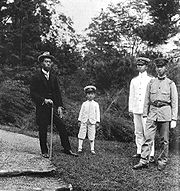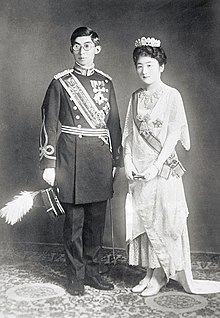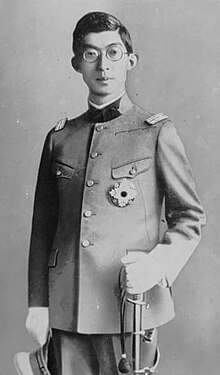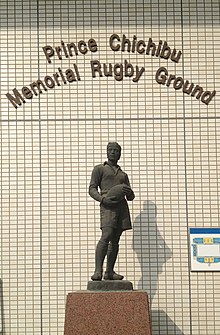Yasuhito, Prince Chichibu
| Yasuhito | |
|---|---|
| Prince Chichibu | |
 Prince Chichibu in December 1940 | |
| Born | Yasuhito, Prince Atsu (淳宮雍仁親王) 25 June 1902 Aoyama Detached Palace, Tokyo City, Japan |
| Died | 4 January 1953 (aged 50) Kugenuma Villa, Fujisawa, Kanagawa, Japan |
| Burial | 12 January 1953 Toshimagaoka Imperial Cemetery, Bunkyo, Tokyo |
| Spouse | |
| House | Imperial House of Japan |
| Father | Emperor Taishō |
| Mother | Sadako Kujō |
| Military career | |
| Allegiance | |
| Service | |
| Years of service | 1922–1945 |
| Rank | |
| Commands | 31st Infantry |
| Battles / wars | Second Sino-Japanese War World War II |
Yasuhito, Prince Chichibu (秩父宮雍仁親王, Chichibu-no-miya Yasuhito Shinnō, 25 June 1902 – 4 January 1953) was the second son of Emperor Taishō (Yoshihito) and Empress Teimei (Sadako), a younger brother of Emperor Shōwa (Hirohito) and a general in the Imperial Japanese Army. As a member of the Imperial House of Japan, he was the patron of several sporting, medical, and international exchange organizations. Before and after World War II, the English-speaking prince and his wife attempted to foster good relations between Japan and the United Kingdom and enjoyed a good rapport with the British royal family. As with other Japanese imperial princes of his generation, he was an active-duty career officer in the Imperial Japanese Army. Like all members of the imperial family, he was exonerated from criminal prosecutions before the International Military Tribunal for the Far East by Douglas MacArthur.
Background and family
[edit]
Born at Aoyama Detached Palace in Tokyo, the second son of Crown Prince Yoshihito (later Emperor Taishō) and Crown Princess Sadako (later Empress Teimei), the prince was originally titled Atsu no miya (Prince Atsu). He and his elder brother were separated from their parents and entrusted to the care of a respected ex-naval officer, Count Sumiyoshi Kawamura and his wife. After Kawamura died in 1904, the young princes rejoined their parents at the Tōgū-gosho (Crown Prince's residence) on the grounds of the Akasaka estate. He attended the elementary and secondary departments of the Gakushuin Peers' School along with Crown Prince Hirohito, and his younger brother, Prince Nobuhito (born in 1905). (A fourth brother, Prince Takahito, was born in 1915). Prince Chichibu enrolled in the Central Military Preparatory School in 1917 and then in the Imperial Japanese Army Academy in 1922.
On 26 May 1922, Emperor Taishō granted his second son the title Chichibu no miya and the authorization to start a new branch of the imperial family. In 1925, the Prince went to Great Britain to study at Magdalen College, Oxford. While in Great Britain King George V decorated Prince Chichibu with the Grand Cross of the Royal Victorian Order. Prince Chichibu had a reputation as an outdoorsman and alpinist during his stay in Europe (he was elected to Honorary membership of the Alpine Club in 1928, struck of in the second world war but then his Honorary membership was reinstated in 1952).[1] He returned to Japan in January 1927 following the death of Emperor Taishō, who for some time had suffered from debilitating physical and mental ill-health. Until the birth of his nephew, Crown Prince Akihito in December 1933, Prince Chichibu was heir presumptive to the Chrysanthemum throne.
Marriage
[edit]
On 28 September 1928, the prince married Matsudaira Setsuko (9 September 1909 – 25 August 1995), the daughter of Matsudaira Tsuneo, Japanese ambassador to the United States and later Great Britain (and later, Imperial Household Minister), and his wife, the former Nabeshima Nobuko. Although technically born a commoner, the new princess was a scion of the Matsudaira of Aizu, a cadet branch of the Tokugawa shogunate. Her paternal grandfather was Matsudaira Katamori, the last daimyō of Aizu, whose heir had been created a viscount in the new kazoku system in 1884. Prince and Princess Chichibu had no children, as Princess Chichibu's only pregnancy ended in a miscarriage.
Military career
[edit]
Prince Chichibu received his commission as a second lieutenant in the infantry in October 1922 and was assigned to the First Imperial Guard Division. He was promoted to first lieutenant in 1925 and became a captain in 1930 after graduation from the Army War College. He received a promotion to the rank of major and assigned to command the Thirty First Infantry Division stationed at Hirosaki, Aomori in August 1935. Prince Chichibu was a vehement ultra-right-wing militarist who increasingly influenced Japanese military policy in the prewar era.[2]
Prince Chichibu has been implicated by some historians in the abortive 26 February Incident in 1936. How much of a role he actually played in that event remains unclear, but it was clear that he was sympathetic to the rebels[3] and that his political sentiments were in agreement with theirs, i.e., replacement of the corrupt political party based government with a military dictatorship under direct control of the emperor. His sympathy to the Kodoha faction within the Imperial Japanese Army was well known at the time. After the assassination of prime minister Inukai Tsuyoshi in 1932, he had many violent arguments with his brother, Emperor Hirohito, about the suspension of the constitution and the implementation of direct imperial rule.
After the coup attempt, the prince and his wife were sent on a tour of Western Europe taking several months. They represented Japan at the May 1937 coronation of King George VI and Queen Elizabeth of the United Kingdom in Westminster Abbey and subsequently visited Sweden and the Netherlands as the guests of King Gustaf V and Queen Wilhelmina, respectively. This tour ended with the visit of Nuremberg in Germany by the prince alone. There he attended the Nuremberg rally and met Adolf Hitler, with whom he tried to boost relations. At Nuremberg Castle, Hitler launched a scathing attack against Joseph Stalin, after which the prince privately said to his aide-de-camp Masaharu Homma: "Hitler is an actor, it will be difficult to trust him". Nevertheless, he remained convinced that the future of Japan was linked to Nazi Germany and in 1938 and 1939, he had many quarrels with the Emperor about the opportunity to join a military alliance with Germany against Great Britain and the United States.
Prince Chichibu Yasuhito was subsequently appointed battalion commander of Thirty-First Infantry Regiment in August 1937, promoted to lieutenant colonel in March 1938 and to colonel in August 1939. During the war, he was involved in combat operations, and was sent to Manchukuo before the Nomonhan incident and to Nanjing after the Nanjing Massacre. On 9 February 1939, Chichibu attended a lecture on bacteriological warfare, given by Shirō Ishii, in the War Ministry Grand Conference Hall in Tokyo.[4] He also attended vivisection demonstrations by Ishii.[5]
According to a version told in her memoirs by Princess Chichibu (Setsuko), according to which the prince retired from active duty after being diagnosed with pulmonary tuberculosis in June 1940, spent most of World War II convalescing at his villa in Gotemba, Shizuoka Prefecture, on the eastern foot of Mount Fuji and never really recovering from his illness.[6][page needed] He was promoted to major general in March 1945.
Patronage
[edit]After World War II, Prince Chichibu was honorary head of many athletic organizations, and was nicknamed the "sporting Prince" due to his efforts to promote skiing, rugby and other sports. He was also honorary President of both the Japan–British Society and the Swedish Society of Japan. He was a supporter of Scouting in Japan and attended the Fourth International Conference in 1926.[7][page needed]
Rugby union
[edit]

The prince was also instrumental in securing the development of rugby union in Japan. He was "converted" to rugby after the JRFU president, Shigeru Kayama, returned from a long sea voyage and was able to "market" the game to Prince Chichibu.[8][page needed]
After his death, the Tokyo Rugby Stadium in Kita-Aoyama 2-chome was renamed Chichibunomiya Rugby Stadium. A statue of Prince Chichibu in rugby kit was erected there.
Death
[edit]Prince Chichibu died from tuberculosis at his Kugenuma villa in Fujisawa, Kanagawa on 4 January 1953. His remains were cremated and the ashes buried at Toshimagaoka Cemetery (豊島岡墓地), Bunkyō, Tokyo, on 12 January 1953.
Ancestry
[edit]| Ancestors of Yasuhito, Prince Chichibu | |||||||||||||||||||||||||||||||||||||||||||||||||||||||||||||||||||||||||||||||||||||||||||||||||||||||||||||||||||||||||||||||||||||||||||||||||||||||||||||||||||||||||||||||||||||||||||||||||||||||||||||||||||||||||||||||||||||||||||||||||||||||||||||||||||||||||||||||||||||||||
|---|---|---|---|---|---|---|---|---|---|---|---|---|---|---|---|---|---|---|---|---|---|---|---|---|---|---|---|---|---|---|---|---|---|---|---|---|---|---|---|---|---|---|---|---|---|---|---|---|---|---|---|---|---|---|---|---|---|---|---|---|---|---|---|---|---|---|---|---|---|---|---|---|---|---|---|---|---|---|---|---|---|---|---|---|---|---|---|---|---|---|---|---|---|---|---|---|---|---|---|---|---|---|---|---|---|---|---|---|---|---|---|---|---|---|---|---|---|---|---|---|---|---|---|---|---|---|---|---|---|---|---|---|---|---|---|---|---|---|---|---|---|---|---|---|---|---|---|---|---|---|---|---|---|---|---|---|---|---|---|---|---|---|---|---|---|---|---|---|---|---|---|---|---|---|---|---|---|---|---|---|---|---|---|---|---|---|---|---|---|---|---|---|---|---|---|---|---|---|---|---|---|---|---|---|---|---|---|---|---|---|---|---|---|---|---|---|---|---|---|---|---|---|---|---|---|---|---|---|---|---|---|---|---|---|---|---|---|---|---|---|---|---|---|---|---|---|---|---|---|---|---|---|---|---|---|---|---|---|---|---|---|---|---|---|---|---|---|---|---|---|---|---|---|---|---|---|---|---|---|---|---|
| |||||||||||||||||||||||||||||||||||||||||||||||||||||||||||||||||||||||||||||||||||||||||||||||||||||||||||||||||||||||||||||||||||||||||||||||||||||||||||||||||||||||||||||||||||||||||||||||||||||||||||||||||||||||||||||||||||||||||||||||||||||||||||||||||||||||||||||||||||||||||
Patrilineal descent
[edit]Gallery
[edit]-
Prince Chichibu in his twenties, as a second lieutenant
-
Prince and Princess Chichibu wedding
-
Prince Chichibu in stadium
-
Prince Chichibu at Hirosaki
-
Former villa of Prince Chichibu in Gotemba
-
Statue of Prince Chichibu
-
The hakkō ichiu monument (1940) had Prince Chichibu's calligraphy of Hakkō ichiu on its front side.
See also
[edit]- Yamashita's gold - an urban legend about Prince Chichibu
Notes
[edit]- ^ Blakeney, T.S. (1963). "Alpine Notes" (PDF). Alpine Journal. #68: 293–306. ISSN 0065-6569. Retrieved 13 October 2024.
- ^ Harris, Sheldon (1995). Factories of Death: Japanese Biological Warfare, 1932–45, and the American Cover-Up. Routledge. p. 142. ISBN 978-0415932141.
- ^ Peter Wetzler, Hirohito and War, University of Hawai'i press, 1998, p.189
- ^ Sheldon Harris, Factories of Death, 2002, p. 142
- ^ Sheldon Harris, Japanese Biomedical Experimentation during the World War II Era, in Military Medical Ethics, volume 2, 2003, p. 469
- ^ Princess Chichibu, The Silver Drum, Global Oriental, 1996
- ^ John S. Wilson (1959), Scouting Round the World. First edition, Blandford Press.
- ^ Cotton, Fran (Ed.) (1984) The Book of Rugby Disasters & Bizarre Records. Compiled by Chris Rhys. London. Century Publishing. ISBN 0-7126-0911-3
- ^ "Genealogy of the Emperors of Japan" (PDF). Imperial Household Agency. Archived from the original (PDF) on 22 March 2011. Retrieved 30 March 2011.
References
[edit]- Princess Chichibu. The Silver Drum: A Japanese Imperial Memoir. Global Books Ltd. (UK) (May 1996). Trans. Dorothy Britton. ISBN 1-86034-004-0
- Fujitani, T. Splendid Monarchy: Power and Pageantry in Modern Japan. University of California Press; Reprint edition (1998). ISBN 0-520-21371-8
- Lebra, Sugiyama Takie. Above the Clouds: Status Culture of the Modern Japanese Nobility. University of California Press (1995). ISBN 0-520-07602-8
- Scouting Round the World, John S. Wilson, first edition, Blandford Press 1959 p. 67
External links
[edit]- Their Imperial Highnesses Prince and Princess Chichibu at the Imperial Household Agency website
- Newspaper clippings about Yasuhito, Prince Chichibu in the 20th Century Press Archives of the ZBW
- 1902 births
- 1953 deaths
- Children of Emperor Taishō
- People from Minato
- Imperial Japanese Army generals of World War II
- 20th-century deaths from tuberculosis
- Scouting in Japan
- Tuberculosis deaths in Japan
- Honorary Knights Grand Cross of the Royal Victorian Order
- Deified Japanese men
- Sons of Japanese emperors
- Military personnel from Tokyo








